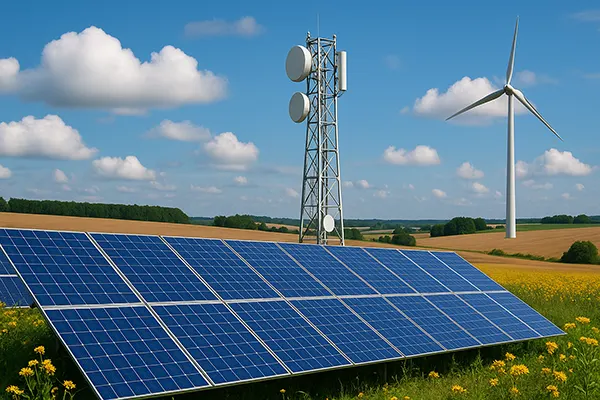Green Internet: How German Providers Are Transitioning to a Sustainable Digital Future

The digital revolution has come with a hefty ecological price. As internet consumption grows, so does the energy demand of data centres, transmission networks, and devices. Germany, home to some of Europe’s largest telecom providers, is pioneering a green transition. Companies like Vodafone, Telekom, and 1&1 are stepping up with tangible sustainability initiatives, aiming to make the internet not just faster, but greener.
Vodafone Germany: From Energy Awareness to Climate Neutrality
Vodafone Germany has implemented a bold plan to decarbonise its operations. Since 2020, Vodafone’s entire network in Germany has been running on 100% renewable electricity. This includes all mobile base stations, data centres, and corporate offices. By eliminating fossil fuels from their operations, the provider has drastically reduced its carbon footprint.
The company’s commitment extends beyond just clean energy. Vodafone’s GigaGreen programme focuses on energy efficiency, the circular economy, and eco-friendly devices. The initiative includes refurbishing routers, using recycled materials in SIM cards, and offering eco-ratings for smartphones to inform consumers of their environmental impact.
Furthermore, Vodafone has pledged to become climate-neutral by 2025 in its own operations and reduce supply chain emissions by 50% by 2030. Their continuous tracking and transparent reporting make them a notable leader in digital sustainability.
Partnerships and Innovation in Green Infrastructure
To scale its green initiatives, Vodafone collaborates with energy providers and infrastructure experts. The company is investing in smart grid technologies, energy storage, and AI to optimise network energy consumption during off-peak hours. Such innovations are essential as mobile traffic and 5G infrastructure expand.
In 2024, Vodafone began testing solar-powered mobile masts in rural areas. These pilot projects have shown promise in reducing grid dependency and operational costs. With Germany’s push for decentralised energy systems, Vodafone’s approach aligns with national climate goals.
These efforts reflect a broader strategy to embed sustainability into every aspect of operations—from technology procurement to customer interaction—ensuring a long-term ecological and financial payoff.
Telekom: Eco-Efficient Networks and Transparent Sustainability Goals
Deutsche Telekom, Germany’s largest telecom provider, has set ambitious targets for environmental responsibility. Its #GreenMagenta programme is an overarching strategy for reducing environmental impact, ranging from energy-efficient data centres to green logistics and sustainable packaging.
By 2021, Telekom had already achieved 100% renewable electricity sourcing for its European network. The firm plans to be climate-neutral across its entire value chain by 2040. As part of this, they are modernising their network infrastructure to minimise energy losses and maximise efficiency.
Telekom also runs Europe’s most energy-efficient data centre in Biere, Saxony-Anhalt. This facility uses innovative cooling systems, modular design, and AI monitoring to maintain ultra-low power usage effectiveness (PUE) ratios, significantly lowering operational emissions.
Consumer-Facing Initiatives and Awareness Campaigns
Telekom doesn’t just focus on internal processes. It actively engages consumers with education campaigns on digital sustainability. Through its eco-labeling on devices and customer tips on reducing e-waste, the company helps users make greener choices.
The firm’s trade-in and recycling programme allows customers to return old phones for responsible disposal or refurbishment. In 2024, Telekom reported that over 500,000 devices were given a second life through this system, significantly reducing electronic waste.
Furthermore, Telekom integrates sustainability into its business customer services, offering green cloud solutions and energy-efficient IoT devices to help partners lower their own carbon footprints.

1&1: Green Network from the Ground Up
As a newer entrant building Germany’s fourth mobile network, 1&1 had the unique opportunity to design its infrastructure with sustainability in mind from the outset. The company has committed to using 100% renewable energy in its operations, setting a precedent for climate-conscious network development.
1&1 partners with suppliers and contractors who meet strict environmental criteria. For instance, its fibre-optic expansion projects emphasise minimal disruption and reuse of existing conduits where possible, reducing construction emissions and land usage.
The company also focuses on lightweight base station equipment and shared infrastructure strategies to avoid redundancy and optimise energy usage—a significant move in reducing its ecological footprint at the design stage.
Data Transparency and Long-Term Climate Strategy
In 2025, 1&1 aims to publish its first full environmental impact report aligned with GHG Protocol standards. This initiative will include scope 1, 2, and partially scope 3 emissions, demonstrating accountability across the supply chain.
The company is also exploring partnerships for carbon offsetting, especially targeting unavoidable emissions from transport and manufacturing. It is considering reforestation efforts within Germany as a domestic carbon sink strategy.
By aligning its growth with climate-neutral principles, 1&1 is positioning itself as a sustainable alternative in a competitive market, appealing to both eco-conscious customers and investors.
